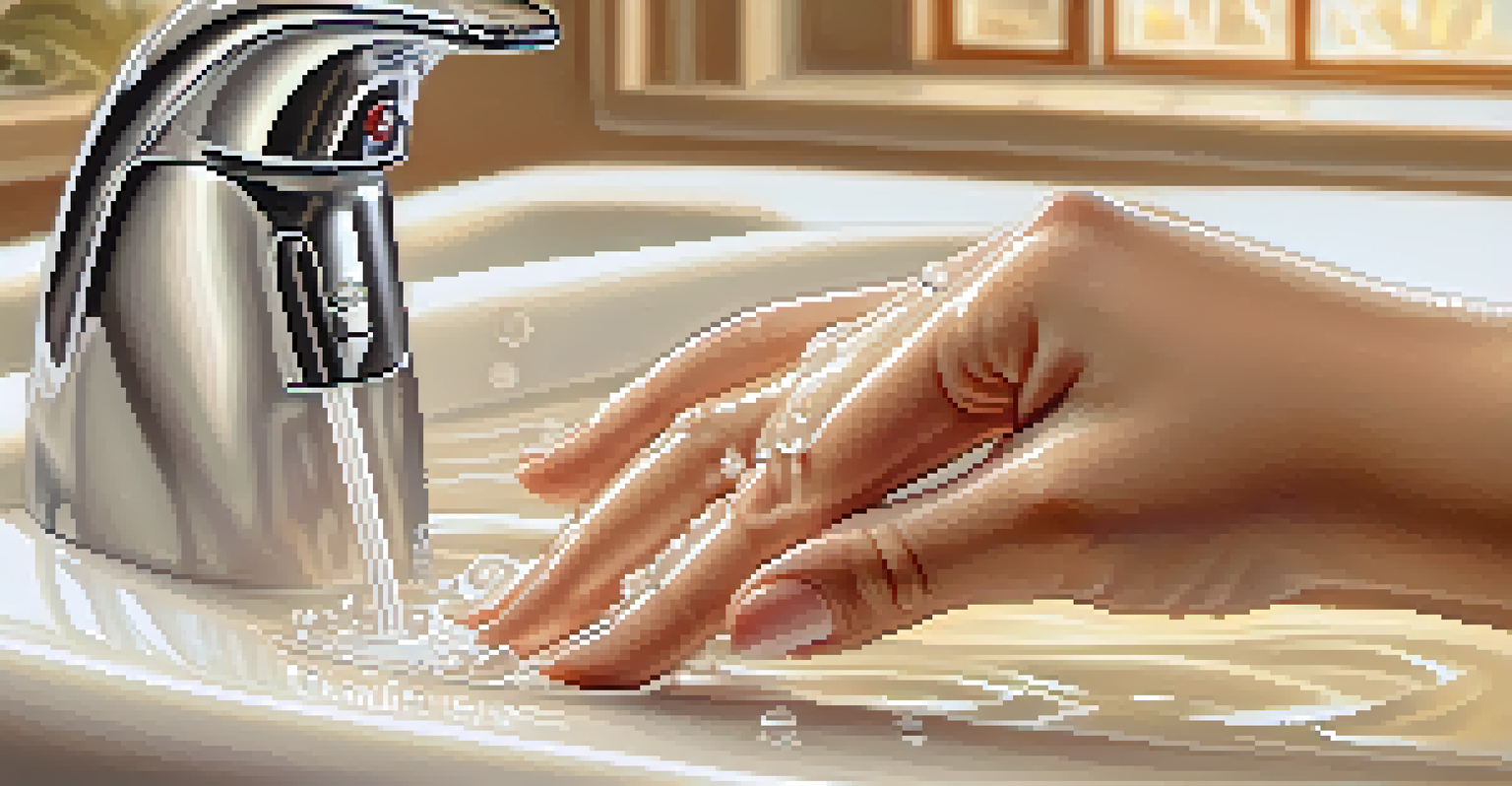The Ultimate Guide to Bathing for Skin Health

Understanding the Importance of Bathing for Skin Health
Bathing is more than just a daily routine; it plays a crucial role in maintaining healthy skin. Regular baths help remove dirt, sweat, and dead skin cells that can clog pores and lead to breakouts. Moreover, they provide an opportunity to hydrate the skin and promote its natural barrier function.
The skin is a mirror of the body and the mind; it reflects how we treat ourselves in every way.
When you think about it, your skin is your body's largest organ, and just like any other part of your body, it needs care and attention. Missing out on proper bathing can lead to dryness, irritation, and even skin conditions like eczema. So, understanding how to bathe effectively is essential for your skin's well-being.
In essence, bathing can be seen as a ritual for rejuvenation, offering both physical and mental benefits. It’s not just about cleanliness; it’s about creating a moment where you nurture your skin and yourself. Let's dive deeper into the specifics of how to maximize your bathing routine.
Choosing the Right Water Temperature for Your Skin
The temperature of the water you bathe in can significantly affect your skin's health. While it might be tempting to soak in hot water, especially during colder months, this can strip your skin of its natural oils, leading to dryness and irritation. Instead, aim for warm water, which is gentler and allows for effective cleansing without over-drying.

Think of your skin like a sponge; it can only absorb so much before it becomes overwhelmed. Hot water can cause that sponge to lose its moisture, resulting in a parched appearance. By opting for lukewarm water, you're helping your skin maintain its hydration while still enjoying a soothing bath experience.
Bathing is Key for Skin Health
Regular bathing removes impurities and hydrates the skin, essential for maintaining its natural barrier.
In addition, consider taking shorter baths or showers to minimize water exposure. This not only conserves water but also reduces the chances of your skin losing essential oils. Remember, the goal is to keep your skin healthy and happy, so water temperature is a vital consideration.
The Best Soaps and Cleansers for Healthy Skin
Using the right soap or cleanser is key to achieving healthy skin during your bathing routine. Opt for gentle, moisturizing cleansers that are free from harsh chemicals and fragrances. Ingredients like glycerin and natural oils can help clean your skin without stripping it of moisture.
Your skin is your best accessory. Take good care of it.
A good rule of thumb is to avoid products with sulfates, as these can be overly drying. Instead, look for products labeled as 'hydrating' or 'for sensitive skin.' These options are generally formulated to be more skin-friendly, ensuring your bath leaves you feeling refreshed rather than parched.
Moreover, remember to apply cleansers sparingly. A little goes a long way, and using too much can lead to irritation. Focus on areas that need extra care, and allow the water to do most of the work in cleansing your skin.
Incorporating Exfoliation into Your Bathing Routine
Exfoliation is an essential aspect of skin health that shouldn’t be overlooked. By gently removing dead skin cells, you can promote a smoother texture and a more radiant complexion. Incorporating exfoliating products or techniques, like a body scrub or loofah, can enhance your bathing experience and improve your skin's overall appearance.
However, moderation is key. Over-exfoliating can lead to irritation and sensitivity, so aim for once or twice a week, depending on your skin type. For sensitive skin, consider using mild exfoliants to avoid any harsh reactions.
Choose Water Temperature Wisely
Opting for warm water instead of hot can help preserve your skin's natural oils and prevent dryness.
Think of exfoliation as a fresh start for your skin; it’s like clearing away the clutter to reveal a brighter you. Just remember to follow up with a good moisturizer post-exfoliation to keep your skin hydrated and balanced.
The Role of Moisturizers After Bathing
Applying moisturizer after bathing is one of the most effective ways to lock in hydration. Your skin is often more permeable right after a bath, making it the perfect time to apply a rich moisturizer. Look for products that contain ingredients like hyaluronic acid or ceramides, which help to retain moisture and support your skin's barrier.
Think of your moisturizer as a protective shield. It not only hydrates your skin but also acts as a barrier against environmental factors that can lead to dryness. Applying it while your skin is still slightly damp can help seal in that moisture for longer-lasting hydration.
Additionally, consider using different moisturizers for different seasons. Thicker creams can be beneficial in winter, while lightweight lotions might be more suitable for summer. Tailoring your products to the season ensures your skin stays nourished and comfortable all year round.
Exploring Natural Ingredients for Bathing
Natural ingredients can elevate your bathing experience and benefit your skin health. Ingredients like oatmeal, honey, and coconut oil have long been celebrated for their soothing and moisturizing properties. For instance, oatmeal baths can help relieve itching and irritation, making them ideal for sensitive skin.
You might also consider adding essential oils to your bath for aromatherapy benefits. Oils like lavender or chamomile not only provide a calming scent but can also promote relaxation and stress relief. Just remember to dilute them properly in a carrier oil to avoid skin irritation.
Moisturize After Bathing
Applying moisturizer post-bath locks in hydration and protects skin from environmental stressors.
Integrating these natural elements into your bathing routine allows for a more holistic approach to skincare. It’s about using what nature offers to nourish and pamper your skin, creating a spa-like experience right at home.
Common Bathing Mistakes to Avoid for Skin Health
Even with the best intentions, it's easy to make mistakes in your bathing routine that can negatively impact your skin. One common pitfall is bathing too frequently; while cleanliness is important, overdoing it can strip your skin of its natural oils. Aim for a balance that works for your lifestyle and skin type.
Another mistake is neglecting to moisturize after bathing. Skipping this step can leave your skin feeling tight and dry, defeating the purpose of your cleansing routine. Make it a habit to apply moisturizer immediately after drying off to keep your skin hydrated.

Lastly, be cautious with loofahs and scrubs. While they’re great for exfoliation, using them too aggressively can lead to micro-tears in the skin. Gentle is the name of the game; treat your skin with kindness for the best results.
Creating a Bathing Routine That Works for You
Establishing a bathing routine tailored to your skin's needs is essential for maintaining skin health. Start by assessing your skin type—whether it’s dry, oily, sensitive, or a combination—and choose products accordingly. This personalized approach will help you select the right cleansers and moisturizers that work best for your unique skin.
Consider the time of day that works best for you. Some people find that bathing in the evening helps them unwind, while others prefer a refreshing morning shower. Whatever your preference, incorporating regular baths into your routine can enhance your overall well-being.
Finally, don’t forget to listen to your skin. If something doesn’t feel right or if you notice irritation, don’t hesitate to adjust your routine. Your skin is your best guide, and finding what feels good will lead you to healthier, happier skin.